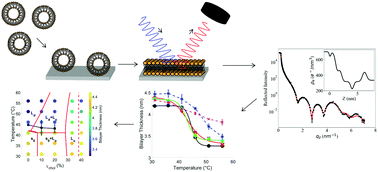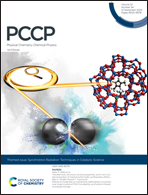Structure of supported DPPC/cholesterol bilayers studied via X-ray reflectivity†
Abstract
The electron density profile of bilayers of DPPC/cholesterol mixtures supported on semiconductor grade silicon substrates were studied with the objective of determining how the proximity of a solid interface modifies the phase diagram of mixed bilayers. The bilayers were studied in situ immersed in water via synchrotron X-ray reflectivity (XRR). Measurements were performed as a function of temperature through the main phase transition and cholesterol mole fractions up to 40%. Analysis of XRR yields the bilayer thickness, roughness and leaflet asymmetry. We find that the structure of the pure DPPC bilayers in the gel phase is in agreement with previous X-ray measurements of supported bilayers deposited via vesicle fusion and multilamellar vesicles but show more clearly defined features than measurements made on films formed using Langmuir–Blodget Langmuir–Shaffer (LB) deposition. Examination of bilayer thickness vs. temperature shows that the melting temperature for supported bilayers is shifted upwards by approximately 4 °C relative to multilamellar vesicles and that the melting temperature decreases with increasing cholesterol content up to 20%. For pure DPPC bilayers the leaflets melt in two stages with the distal leaflet melting first. For cholesterol concentrations of 10% and 20% there is no clear indication of separate melting. For 33% and 40% cholesterol content no clear transition is seen in the bilayer thickness, but an abrupt change in roughness indicates possible microdomain formation in the 40% cholesterol sample.



 Please wait while we load your content...
Please wait while we load your content...